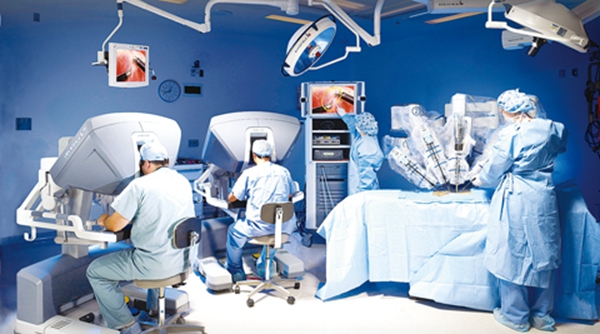Surgical robots can be used for remoteregional anesthesia
According to a study published in theSeptember issue of anesthesia and analgesia, existing surgical robots can beused to perform complex regional anesthesia operations - in theory,professional anesthesiologists can perform robot assisted anesthesia operationsremotely. Now there are rigorous trials of robot assisted regional anesthesia."This study shows that multifunctional surgical robots can be used tosimulate nerve block," according to Dr. Patrick J. Tighe, PhD, andcolleagues at the University of Florida School of medicine in Genesville.
Surgical robot can be used for remoteanesthesia.

The researchers conducted a series ofsimulation studies to evaluate the feasibility of robotic assisted regionalanesthesia. The simulation experiment uses the existing surgical robot Da Vincisystem. It consists of four robot arms and a high-definition stereo camera,which can perform various types of robot assisted surgery.
This process is not carried out in realpatients, but the use of ultrasound "mannequins" to simulate theanesthesiologist's ultrasound-guided operation. The anesthesiologist is in theoperating room, but away from robotic arms and simulated "patients,"using the Da Vinci system operator console. After the ultrasound probe wasplaced, the anesthesiologist was able to successfully simulate the nerve blockprocess, including identifying the neural structure, picking up the needle andlocating the target nerve, and finally completing the injection. Surgicalrobots are then used to try out more advanced regional anesthesia: placement ofnerve peripherals for continuous nerve block. Although some of the steps haveto be done manually, most of the complex catheter placement process can beaccomplished successfully through the Da Vinci system. There are some importantlimitations in the process of performing the simulation, including that somesteps have to be done manually, and the multi-million dollar price of the DaVinci system is another obstacle to clinical application. However,"simulation studies have shown that robotic assisted regional anesthesiausing existing clinical devices is feasible," Dr Tighe and his colleagueswrote. Further research is needed to promote the development of this concept,including "optimizing the interface between robot and other nerve blockdevices".
In the future, robotics can be used forremote "remote anesthesia" operations. "There are very fewskilled regional anesthesiologists to meet the demand," says Steven L.Shafer, PhD, Columbia University, chief editor of anesthesia and pain."The technology is still in its infancy. If future research shows that itis feasible, a trained anesthesiologist can provide specialized nerve block todozens of patients worldwide in one day. There will still be a need foranesthesiologists to take care of patients, to deal with various complications,and to provide backup anesthesia in case of anesthesia failure. "



 粤ICP备16107690号-1
粤ICP备16107690号-1 